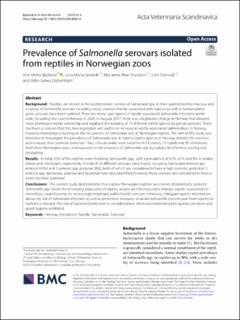| dc.description.abstract | Background
Reptiles are known to be asymptomatic carriers of Salmonella spp. in their gastrointestinal mucosa and a variety of Salmonella serovars including exotic serovars mainly associated with reptiles as well as human pathogenic serovars have been isolated. There are many case reports of reptile-associated Salmonella infections worldwide, including one case in Norway in 2000. In August 2017, there was a legislative change in Norway that allowed more permissive reptile ownership and legalized the keeping of 19 different reptile species by private persons. There has been a concern that this new legislation will lead to an increase in reptile-associated salmonellosis in Norway, however knowledge is lacking on the occurrence of Salmonella spp. in Norwegian reptiles. The aim of this study was therefore to investigate the prevalence of Salmonella spp. in captive reptile species in Norway, identify the serovars and evaluate their zoonotic potential. Thus, cloacal swabs were taken from 53 snakes, 15 lizards and 35 chelonians from three Norwegian zoos, and assessed for the presence of Salmonella spp. by culture, biochemical testing and serotyping.
Results
In total, 43% of the reptiles were shedding Salmonella spp., with a prevalence of 62%, 67% and 3% in snakes, lizards and chelonians, respectively. A total of 26 different serovars were found, including Salmonella enterica spp. enterica (40%) and S. enterica spp. arizonae (4%), both of which are considered to have a high zoonotic potential. S. enterica spp. diarizonae, salamae and houtenae were also identified, however these serovars are considered to have a lower zoonotic potential.
Conclusions
The current study demonstrates that captive Norwegian reptiles are carriers of potentially zoonotic Salmonella spp. Given the increasing popularity of reptiles as pets and the legislative change, reptile-associated salmonellosis could become an increasingly important public health concern in Norway. Adequate public information about the risk of Salmonella infection as well as preventive measures to avoid Salmonella transmission from reptiles to humans is needed. The risk of Salmonella infection is considered low when recommended precautions are taken and good hygiene exhibited. | en_US |

